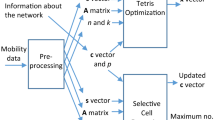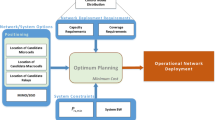Abstract
Deployment of cellular networks involves substantial capital investment. Competition motivates service providers to minimize these costs while maintaining service quality. We develop a cost-minimizing planning model that simultaneously determines three important variables – base station location, power level and frequency group assignments for the antennas at each selected base station. It can represent different antenna configurations and frequency groups commonly used in practice. The integer-programming problem is solved using a Lagrangian relaxation based heuristic and computational tests indicate good solution quality for reasonably large problems. We also note the appropriate role of such optimization models in the overall planning process.
Similar content being viewed by others
References
R. Arnott, S. Ponnekanti, C. Taylor and H. Chaloupka, Advanced base station technology, IEEE Communications Magazine 36 (1998) 96–102.
E. Balas and A. Ho, Set covering algorithms using cutting planes, heuristics, and subgradient optimization: a computational study, Mathematical Programming Study 12 (1980) 37–60.
J.R. Boucher, Traffic System Design Handbook (IEEE Press, 1993) PP3251–TBR.
V. Brass and W.F. Fuhrmann, Traffic engineering experience from operating cellular networks, IEEE Communications Magazine 35 (1997) 66–71.
S. Ceria, C. Manino and A. Sassano, Planning tools help designers optimize cellular networks, in: Wireless Design Online (1999). http://www.wirelessdesignonline.com/content/news/article.asp? DocID=206FD7–F4FB–11D2–A405–00C04F4F7C39.
Ch. Church et al., Wireless vs. wireline telephony page, University of Hawaii (1999). http:// www2.hawaii.edu/ lian/com681/tutor/cellular.html.
Congressional Budget Office, Where Do We Go from here?: The FCC Auctions and the Future of Radio Spectrum Management (Congress of the U.S., Washington, DC, 1997).
D. Erlenkotter, A dual–based procedure for uncapacitated facility location, Operations Research 26 (1978) 992–1009.
J. Etcheberry, The set covering problem: a new implicit enumeration algorithm, Operations Research 25 (1977) 760–772.
Federal Communications Commission, Spectrum Allocation Chart (Washington DC, 1999). http:// www.fcc.gov.
Federal Communications Commission, Cellular Summary (2000). http://www.fcc.gov/wtb/ cellular/celfctsh.html.
M.R. Garey and D.S. Johnson, Computers and Intractability: A Guide to the Theory of NP–completeness (Freeman, San Francisco, 1979).
A. Harris, Europe hit by mobile's runaway success, Communications International 26 (1999) 16–18.
V. Hsu and R. DeMatta, An efficient heuristic approach to recognize the infeasibility of a loading problem, International Journal of Flexible Manufacturing Systems 9 (1996) 31–50.
M. Jensen, Wireless in Africa, Telecommunications 32 (1998) S6–S8.
W.C.Y. Lee, Mobile Cellular Telecommunications: Analog and Digital Systems (McGraw–Hill, New York, 1995).
R.K. Leeper, System design and installation, Cellular Business 4 (1987) 12–16.
N.C. Lerner, Latin American telecom changes: learning from Mexico and Brazil, Telecommunications 33 (1999) 25–30.
R.C.V. Macario, Cellular Radio: Principles and Design (McGraw–Hill, New York, 1997).
R.E. Marsten, An algorithm for large scale set partitioning problems, Management Science 20 (1972) 774–787.
N. Megiddo and K.J. Supowit, On the complexity of some common geometric location problems, SIAM Journal of Computing 13 (1984) 182–196.
L.J. Meyer, Cell site antennas, Cellular Business 3 (1986) 14–18.
M. Nigh, CDMA searches for global acceptance, Wireless Review 16 (1999) 10.
F. Perez–Fontan and J.M.H. Rabanos, Educational cellular radio network planning software tool, IEEE Transactions on Education 41 (1998) 203–215.
R. Potter, Squeezing the cellular network, Telecommunications 33 (1999) 63–66.
M.J. Riezenman, Technology 1998 analysis & forecast: Communications, IEEE Spectrum 36 (1999) 29–34.
H.G. Sandalidis, P.P. Stavroulakis and J. Rodriguez–Tellez, Borrowing channel assignment strategies based on heuristic techniques for cellular systems, IEEE Transactions on Neural Networks 10 (1999) 176–181.
R.E. Schwartz, Wireless Communications in Developing Countries: Cellular and Satellite Systems (Artech House, Boston, MA, 1996).
B. Schweber, Smart antennas shape base–station patterns to traffic needs, EDN 44 (1999) 42–44.
K. Singh and D.L. van Oudheusden, A branch and bound algorithm for the traveling purchaser problem, European Journal of Operational Research 97 (1997) 571–579.
C. Smith, Propagation models, Cellular Business 12 (1995) 72.
T.J. Van Roy, A cross decomposition algorithm for capacitated facility location, Operations Research 34 (1986) 145–163.
A.J. Viterbi, CDMA: Principles of Spread Spectrum Communication (Addison–Wesley, Reading, MA, 1995).
J.H. Winters, Smart antennas for wireless systems, IEEE Personal Communications 5 (1998) 23–27.
Anonymous, Mobile competition heats up: A European perspective, Telecommunications 32 (1998) S3–S15.
Author information
Authors and Affiliations
Rights and permissions
About this article
Cite this article
Dutta, A., Hsu, V. Cellular Network Design Site Selection and Frequency Planning. Annals of Operations Research 106, 287–306 (2001). https://doi.org/10.1023/A:1014522011336
Issue Date:
DOI: https://doi.org/10.1023/A:1014522011336




